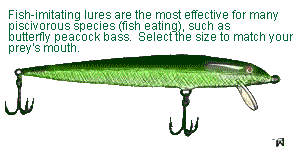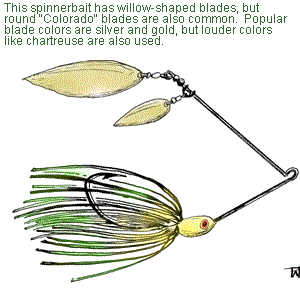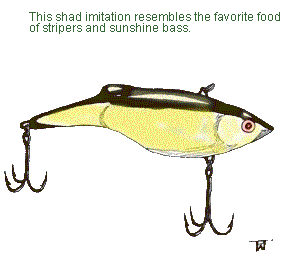 |
|
|
Home | Boating | Fishing | Diving | Water Sports | Boating Safety | Environment | Weather | Photo Blog | Add Your Company to the Directory |
| You Are Here > Home > Florida Fishing > Freshwater Fishing > Freshwater Fishing Tips |
 Freshwater
Fishing Tips Freshwater
Fishing TipsHere's How to Catch the Big Ones! Spring is the best time of year to catch bass, when fish move into shallow water to spawn. Spawning may occur as early as January in extreme south Florida and as late as May in the panhandle, but March and April are peak months. Most large bass are taken at this time; after spawning, many large females move to offshore areas. The best live bait is a golden shiner, fished under a float or free-lined. Typically, the shiner is hooked through the lips or back with a large hook, 2/0 to 5/0. A medium to medium-heavy rod with 14- to 20-pound test line is preferred, particularly when fishing in areas with thick vegetation or cover. The plastic worm is the most dependable artificial bait for largemouth bass. A weedless "Texas- or Carolina-rigged" worm is effective for fishing Florida lakes with heavy plant cover. Worms come in a variety of colors and scents, and bass may favor certain types depending on light conditions; be sure to have both light and dark colors available, as well as several sizes of tapered worm weights from 1/8 to ounce. Purple "metalflake" or "red shad" worms with twirly-tails are popular, and plastic lizards can be effective as well. Most plastic worms are worked slowly along the bottom or through cover by raising the rod tip a few feet, then allowing the worm to sink. The line should be kept fairly tight to feel the strike. Typically an angler will feel the bass "tap" the worm once or twice lightly. By lowering the rod tip and waiting only until the slack is out of the line before setting the hook, anglers greatly lessen the chance of injury to the fish due to deep hooking. With active bass and dense underwater vegetation, "jerk worms" are an excellent bait. Rigged without sinkers, these worms are jigged rapidly over vegetation, with brief pauses to let the worm sink slowly. Bass hit these baits hard, and an instant hookset is recommended.
Crankbaits typically imitate baitfish or crayfish, and a straight retrieve is usually effective. The design of the plastic lip determines how deep the lure dives, and anglers can adjust their choice of baits based on water depth. Popular colors are white, shad, firetiger (green striped with orange underside) and crayfish. Topwater baits are exciting to fish because the angler can see the strike. Topwater plugs that imitate wounded baitfish may be twitched to entice bass. Others are designed to make noise, and a faster, erratic retrieve may antagonize a bass into striking. Topwater lures are most successful during early morning or late afternoon. Stay ready for a surprise strike and set the hook immediately. Although the largemouth bass is by far our most common black bass, other species are found in Florida. The smaller Suwannee bass occurs in the Suwannee River and its tributaries, and in the Ochlockonee River. Favoring rock outcrops and moving water, Suwannee bass prefer crayfish to many prey items of largemouth. Crayfish-imitating crankbaits worked through deep-water bends will attract these hard fighting fish, as will plastic worms, plastic lizards or crayfish. The Santa Fe River is another good spot, and trophy-sized Suwannee bass up to three pounds can be found in the Ochlockonee River north of I-10.
Striped Bass, White Bass and Sunshine Bass
White bass are found in the Apalachicola River, Ochlockonee River and
Lake Talquin. In the same family as stripers, white bass seldom exceed
four pounds, with one- to two-pound fish more common. The best white
bass fishing occurs in the spring, when fish move upriver to spawn.
Small crayfish or grass shrimp on #4 hooks fished in deep river bends or
at the edge of sand bars are effective baits. Put a 1/4
oz. egg sinker above your swivel, with an 8- to 12-inch leader tied to
your hook; use lighter line for the leader, so if you get snagged you
don't have to replace the complete rig. Small jigs in white or brown are
often productive.
The sunshine bass, a hybrid of striped bass and white bass, is
artificially spawned at Commission hatcheries. Hybrids are stocked in
lakes with an abundance of gizzard and threadfin shad. Sunshine bass are
also stocked together with stripers in some river systems, and some of
the best fishing is found in the Apalachicola and St. Johns rivers. The
mouth of the Escambia River near Pensacola has good hybrid fishing, and
sunshine bass feed around the fish attractors in Newnan's Lake near
Gainesville. Live bait, including shad, grass shrimp and crayfish are
especially effective, but jigs, spoons and imitation-minnow plugs also
produce. In urban lakes, shrimp, squid and even cut-up pieces of hot
dogs will attract sunshine bass. Sunshine bass readily concentrate
around mechanical feeders that periodically dispense food pellets.
Catfish |

More than 300 miles of urban canals in
Dade and Broward counties have fishable populations of butterfly peacock
bass, an introduced species that reaches nine pounds. Butterfly peacocks
prefer live fish or fish-imitating lures, rather than plastic worms
commonly used for largemouth bass. The best bait for butterfly peacocks
is live shiners, but artificial lures also work well, including topwater
plugs, jigs and crankbaits. Light spinning tackle is recommended in
canals for this open-water fighter. Intersections, dead ends and fallen
trees concentrate butterfly peacocks. Shade provided by bridges,
culverts, vegetation, and other structures provide some of the most
productive spots. Butterfly peacocks are caught only during daylight
hours, as they do not feed at night.
Panfish The redear sunfish, or shellcracker, is another popular panfish.
Although they prefer snails and clams, redear sunfish are caught most
often on earthworms around the full moons of March and April when their
spawning activity peaks. Redear prefer hard bottom, congregating in
deeper water than bluegill. Shellcracker grow larger than bluegill, with
fish over 1 pound common.
Redbreast sunfish, also known as river bream and redbellies, are the
flowing water cousins of bluegill. Redbellies are more common in rivers
than bluegill, and often can be found in backwater areas with less flow.
The same live baits that work for bluegill will also catch redbreast
sunfish.
The spotted sunfish, or stumpknocker, is an often overlooked stream
panfish. Aptly named, the stumpknocker can be found in the tangle of
roots at the waters edge. Although spotted sunfish rarely exceed eight
inches, this feisty species provide great sport on light tackle. Tiny (1/16
oz.) beetle spins pitched close to the shoreline can be deadly,
particularly tipped with freshwater clam meat. The lower Suwannee River
is one of the best spots for this sportfish.
Black crappie, known locally as speckled perch or specks, are a cool
weather favorite in Florida. Crappie weighing up to two pounds are not
uncommon. The premier fishing location is Lake Okeechobee, but good
crappie fishing can be found throughout the state. Unlike most other
panfish, crappie spend much of their time offshore, feeding on small
fish. Successful anglers often drift through deeper water, fishing with
small minnows or freshwater grass shrimp until they find a school. Try a
light wire #4 hook and small split shot below a float. Speck anglers
typically use several rods or poles, fishing at different depths until
they pinpoint concentrations of fish. Specks move inshore to spawn
during the early spring, sometimes gathering in large numbers around
heavy cover. Crappie also readily strike artificials; 1/16
oz. to 1/8 oz. feathered or curly-tail jigs in white, yellow, pink and
chartreuse are popular. Tipping these jigs with a live minnow makes them
even more effective. Night fishing for crappie is an effective
technique. Any of the above baits fished near a lantern or floodlight
can produce nice stringers. Most crappie fishing occurs in the cooler
months, but anglers who fish into the summer do very well, especially at
night.
|
||||||
 Spinnerbaits
are very good in the spring, usually fished slowly around drop-offs and
cover. If a slow retrieve fails, try "buzzing", i.e., retrieving the
spinnerbait rapidly so the blades ripple the surface.
Spinnerbaits
are very good in the spring, usually fished slowly around drop-offs and
cover. If a slow retrieve fails, try "buzzing", i.e., retrieving the
spinnerbait rapidly so the blades ripple the surface.
 The
best striper fishing occurs from fall through spring, when fish are
actively feeding. Live shad are very effective, particularly below Jim
Woodruff Dam on the Apalachicola River. Stripers may weigh up to 60
pounds; use heavy tackle with 3- to 4-oz. weights in high flow areas. In
the St. Johns River, the Croaker Hole and the jetties at the south end
of Lake George are good fall and spring striper areas, and the first few
miles of the Wekiva River have several locations where stripers
congregate. Live menhaden, golden shiners, croakers or eels are good
choices as bait. Lures, like rattletraps, that resemble baitfish also
produce impressive strikes, including heavy jigs, as well as sinking and
floating lures in white, chrome or chartreuse.
The
best striper fishing occurs from fall through spring, when fish are
actively feeding. Live shad are very effective, particularly below Jim
Woodruff Dam on the Apalachicola River. Stripers may weigh up to 60
pounds; use heavy tackle with 3- to 4-oz. weights in high flow areas. In
the St. Johns River, the Croaker Hole and the jetties at the south end
of Lake George are good fall and spring striper areas, and the first few
miles of the Wekiva River have several locations where stripers
congregate. Live menhaden, golden shiners, croakers or eels are good
choices as bait. Lures, like rattletraps, that resemble baitfish also
produce impressive strikes, including heavy jigs, as well as sinking and
floating lures in white, chrome or chartreuse.